Carrier 50JS User Manual
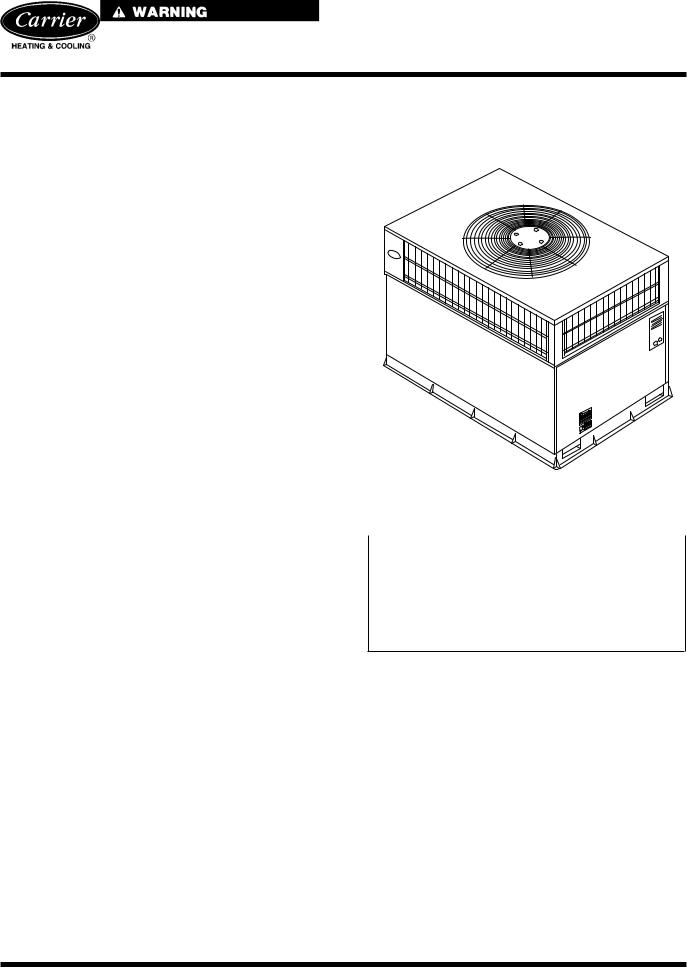
50JS,JX018-060 Single-Package Heat Pump Units
Visit www.carrier.com
Installation, Start-Up and Service Instructions
NOTE: Read the entire instruction manual before starting the installation.
Index |
|
SAFETY CONSIDERATIONS ............................................... |
1-4 |
General ................................................................................. |
4 |
RECEIVING AND INSTALLATION.................................. |
4-15 |
Check Equipment...................................................................... |
4-5 |
Identify Unit.............................................................................. |
4 |
Inspect Shipment....................................................................... |
5 |
Provide Unit Support................................................................... |
5 |
Roof Curb.................................................................................. |
5 |
Slab Mount................................................................................ |
5 |
Ground Mount........................................................................... |
5 |
Provide Clearances....................................................................... |
5 |
Rig and Place Unit.................................................................... |
5-6 |
Select and Install Ductwork .................................................... |
6-8 |
Converting Horizontal Discharge Units to Downflow (Vertical) |
|
Discharge................................................................................... |
6 |
Provide for Condensate Disposal ............................................ |
6-8 |
Install Electrical Connections ..................................................... |
8 |
High-Voltage Connections........................................................ |
8 |
Routing Power Leads Into Unit .......................................... |
8-14 |
Connecting Ground Lead to Ground Lug.............................. |
14 |
Special Procedures for 208-V Operation ............................... |
15 |
PRE-START-UP......................................................................... |
15 |
START-UP............................................................................. |
15-20 |
Check for Refrigerant Leaks .................................................. |
15 |
Unit Start-Up Adjustment ................................................. |
15-20 |
MAINTENANCE .................................................................. |
20-23 |
SYSTEM INFORMATION....................................................... |
23 |
Time Delay Relay ................................................................... |
23 |
Pressure Switches.................................................................... |
23 |
Defrost Thermostat ................................................................. |
23 |
TROUBLESHOOTING ....................................................... |
24-25 |
START-UP CHECKLIST ......................................................... |
25 |
NOTE TO INSTALLER Ð READ THESE INSTRUCTIONS CAREFULLY AND COMPLETELY before installing this unit. Also, make sure the Owner's Manual and Service Instructions are left with the unit after installation.
SAFETY CONSIDERATIONS
Installation and servicing of air-conditioning equipment can be hazardous due to system pressure and electrical components. Only trained and qualified personnel should install, repair, or service air-conditioning equipment.
Untrained personnel can perform basic maintenance functions of cleaning coils and filters. All other operations should be performed by trained service personnel. When working on air-conditioning equipment, observe precautions in the literature, tags and labels attached to the unit, and other safety precautions that may apply.
Follow all safety codes. Wear safety glasses and work gloves. Use quenching cloth for unbrazing operations. Have fire extinguisher available for all brazing operations.
C99001
Fig. 1ÐModel 50JS/JX
Improper installation, adjustment, alteration, service, maintenance, or use can cause explosion, fire, electric shock, or other occurrences, which could cause serious injury or death or damage your property. Consult a qualified installer or service agency for information or assistance. The qualified installer or agency must use only factory-authorized kits or accessories when modifying this product.
Recognize safety information. This is the safety-alert symbol  . When you see this symbol on the product or in instructions or manuals, be alert to the potential for personal injury.
. When you see this symbol on the product or in instructions or manuals, be alert to the potential for personal injury.
Understand the signal words Ð DANGER, WARNING, CAUTION, and NOTE. Danger identifies the most serious hazards, which will result in severe personal injury or death. Warning indicates a condition that could cause serious personal injury or death. Caution is used to identify unsafe practices, which would result in minor personal injury or product and property damage. NOTE is used to highlight suggestions which will result in enhanced installation, reliability or operation.
1.The power supply (volts, phase, and hertz) must correspond to that specified on unit rating plate.
2.The electrical supply provided by the utility must be sufficient to handle load imposed by this unit.
3.This installation must conform with local building codes and with NEC (National Electrical Code). Refer to provincial and local plumbing or waste water codes and other applicable local codes.
Manufacturer reserves the right to discontinue, or change at any time, specifications or designs without notice and without incurring obligations.
Book |
1 |
4 |
PC 101 |
Catalog No. 565-057 |
Printed in U.S.A. |
Form 50JS,JX-1SI |
Pg 1 |
5-00 |
Replaces: 50JX-2SI |
Tab |
5a |
5a |
|
|
|
|
|
|
|
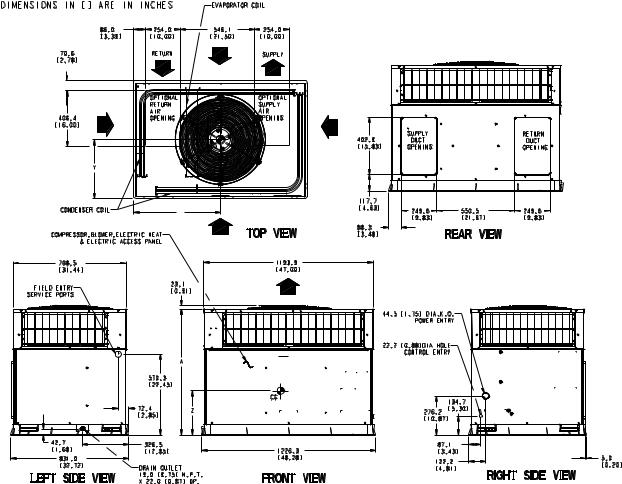
REQUIRED CLEARANCE TO COMBUSTIBLE MATL.
|
INCHES [mm] |
|
TOP OF UNIT................................................................................... |
14.00 |
[355.6] |
DUCT SIDE OF UNIT......................................................................... |
2.00 |
[50.8] |
SIDE OPPOSITE DUCTS ................................................................ |
14.00 |
[355.6] |
BOTTOM OF UNIT ............................................................................. |
0.50 |
[12.7] |
ELECTRIC HEAT PANEL ................................................................. |
36.00 |
[914.4] |
NEC. REQUIRED CLEARANCES. |
INCHES [mm] |
|
|
||
BETWEEN UNITS, POWER ENTRY SIDE .................................... |
42.00 [1066.8] |
|
UNIT AND UNGROUNDED SURFACES, POWER ENTRY SIDE .36.00 [914.0] |
||
UNIT AND BLOCK OR CONCRETE WALLS AND OTHER |
|
|
GROUNDED SURFACES, POWER ENTRY SIDE......................... |
42.00 [1066.8] |
|
REQUIRED CLEARANCE FOR OPERATION AND SERVICING
|
INCHES [mm] |
|
EVAP. COIL ACCESS SIDE............................................................ |
36.00 |
[914.0] |
POWER ENTRY SIDE.................................................................... |
42.00 |
[1066.8] |
(EXCEPT FOR NEC REQUIREMENTS) |
|
|
UNIT TOP ....................................................................................... |
48.00 |
[1219.2] |
SIDE OPPOSITE DUCTS .............................................................. |
36.00 |
[914.0] |
DUCT PANEL ................................................................................. |
12.00 |
[304.8] * |
*MINIMUM DISTANCES: IF UNIT IS PLACED LESS THAN 304.8 [12.00] FROM WALL SYSTEM, THEN SYSTEM PERFORMANCE MAYBE COMPROMISE.
C99007
|
|
UNIT WEIGHT |
UNIT HEIGHT |
|
CENTER OF GRAVITY |
|
|||
UNIT |
ELECTRICAL CHARACTERISTICS |
IN. [MM] |
|
|
IN. [MM] |
|
|||
|
|
|
|
|
|||||
|
|
lb |
kg |
"A" |
X |
|
Y |
|
Z |
|
|
|
|
|
|
|
|
|
|
50JS018 |
208/230-1-60 |
283 |
128.4 |
37.02 [940.3] |
19.5 [495.3] |
|
16.8 [425.5] |
|
15.0 [381.0] |
|
|
|
|
|
|
|
|
|
|
50JS024 |
208/230-1-60 |
289 |
131.1 |
39.02 [991.1] |
18.5 [469.9] |
|
16.8 [425.5] |
|
15.0 [381.0] |
50JS030 |
208/230-1-60, 208/230-3-60 |
287 |
130.2 |
39.02 [991.1] |
19.5 [495.3] |
|
17.5 [444.5] |
|
15.0 [381.0] |
|
|
|
|
|
|
|
|
|
|
50JS036 |
208/230-1-60, 208/230-3-60, 460-3-60 |
291 |
132.0 |
37.02 [940.3] |
19.5 [495.3] |
|
17.8 [450.9] |
|
13.0 [330.2] |
|
|
|
|
|
|
|
|
|
|
50JS042 |
208/230-1-60, 208/230-3-60, 460-3-60 |
323 |
146.5 |
37.02 [940.3] |
19.5 [495.3] |
|
17.8 [450.9] |
|
13.0 [330.2] |
50JX024 |
208/230-1-60 |
299 |
135.6 |
41.02 [1041.9] |
19.0 [482.6] |
|
18.3 [463.6] |
|
16.0 [406.4] |
|
|
|
|
|
|
|
|
|
|
50JX030 |
208/230-1-60,208/230-3-60 |
320 |
145.2 |
37.02 [940.3] |
20.0 [ 508] |
|
19.3 [ 489.0] |
|
17.6 [447.0] |
|
|
|
|
|
|
|
|
|
|
50JX036 |
208/230-1-60,208/230-3-60, 460-3-60 |
328 |
148.8 |
37.02 [940.3] |
20.0 [508] |
|
19.0 [482.6] |
|
16.5 [419.1] |
Fig. 2Ð50JS018-042/50JX024-036 Unit Dimensions
2
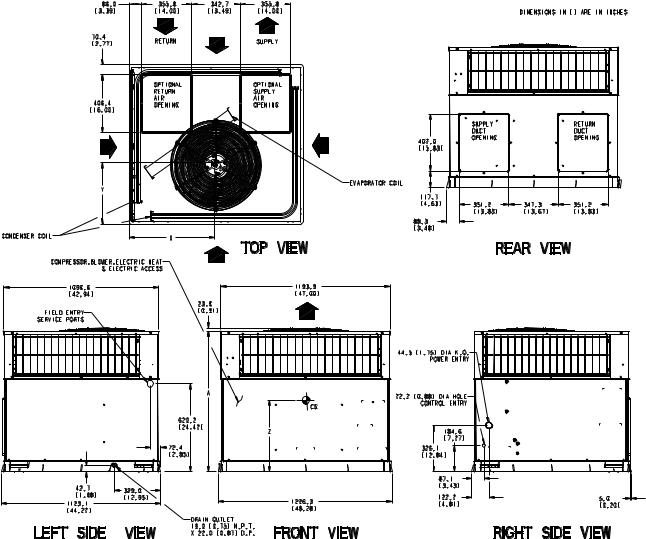
REQUIRED CLEARANCE TO COMBUSTIBLE MATL.
|
INCHES |
[mm] |
TOP OF UNIT................................................................................... |
14.00 |
[355.6] |
DUCT SIDE OF UNIT......................................................................... |
2.00 |
[50.8] |
SIDE OPPOSITE DUCTS ................................................................ |
14.00 |
[355.6] |
BOTTOM OF UNIT ............................................................................. |
0.50 |
[12.7] |
ELECTRIC HEAT PANEL ................................................................. |
36.00 |
[914.4] |
NEC. REQUIRED CLEARANCES. |
INCHES [mm] |
|
|
||
BETWEEN UNITS, POWER ENTRY SIDE .................................... |
42.00 [1066.8] |
|
UNIT AND UNGROUNDED SURFACES, POWER ENTRY SIDE .36.00 [914.0] |
||
UNIT AND BLOCK OR CONCRETE WALLS AND OTHER |
|
|
GROUNDED SURFACES, POWER ENTRY SIDE......................... |
42.00 [1066.8] |
|
REQUIRED CLEARANCE FOR OPERATION AND SERVICING
|
INCHES |
[mm] |
EVAP. COIL ACCESS SIDE............................................................ |
36.00 |
[914.0] |
POWER ENTRY SIDE.................................................................... |
36.00 |
[914.0] |
(EXCEPT FOR NEC REQUIREMENTS) |
|
|
UNIT TOP ....................................................................................... |
48.00 |
[1219.2] |
SIDE OPPOSITE DUCTS .............................................................. |
36.00 |
[914.0] |
DUCT PANEL ................................................................................. |
12.00 |
[304.8] * |
*MINIMUM DISTANCES: IF UNIT IS PLACED LESS THAN 304.8 [12.00] FROM WALL SYSTEM, THEN SYSTEM PERFORMANCE MAYBE COMPROMISE.
C99006
|
|
UNIT WEIGHT |
UNIT HEIGHT |
|
CENTER OF GRAVITY |
|
|||
UNIT |
ELECTRICAL CHARACTERISTICS |
IN. [MM] |
|
|
IN. [MM] |
|
|||
|
|
|
|
|
|||||
|
|
lb |
kg |
"A" |
X |
|
Y |
|
Z |
|
|
|
|
|
|
|
|
|
|
50JS048 |
208/230-1-60, 208/230-3-60, 460-3-60 |
353 |
160.1 |
38.98 [990.2] |
20.5 [520.7] |
|
20.6 [523.8] |
|
17.0 [431.8] |
|
|
|
|
|
|
|
|
|
|
50JS060 |
208/230-1-60, 208/230-3-60, 460-3-60 |
418 |
189.6 |
38.98 [990.2] |
19.5 [495.3] |
|
19.8 [501.7] |
|
17.0 [431.8] |
50JX042 |
208/230-1-60, 208/230-3-60, 460-3-60 |
350 |
158.8 |
40.98 [1040.9] |
21.0 [533.4] |
|
20.5 [520.7] |
|
16.6 [421.6] |
|
|
|
|
|
|
|
|
|
|
50JX048 |
208/230-1-60, 208/230-3-60, 460-3-60 |
355 |
161.0 |
40.98 [1040.9] |
20.0 [508.0] |
|
21.3 [539.8] |
|
18.0 [457.2] |
|
|
|
|
|
|
|
|
|
|
50JX060 |
208/230-1-60, 208/230-3-60, 460-3-60 |
428 |
194.1 |
42.98 [1091.7] |
21.0 [533.4] |
|
20.0 [508.0] |
|
17.6 [447.0] |
Fig. 3Ð50JS048-060/50JX042-060 Unit Dimensions
3
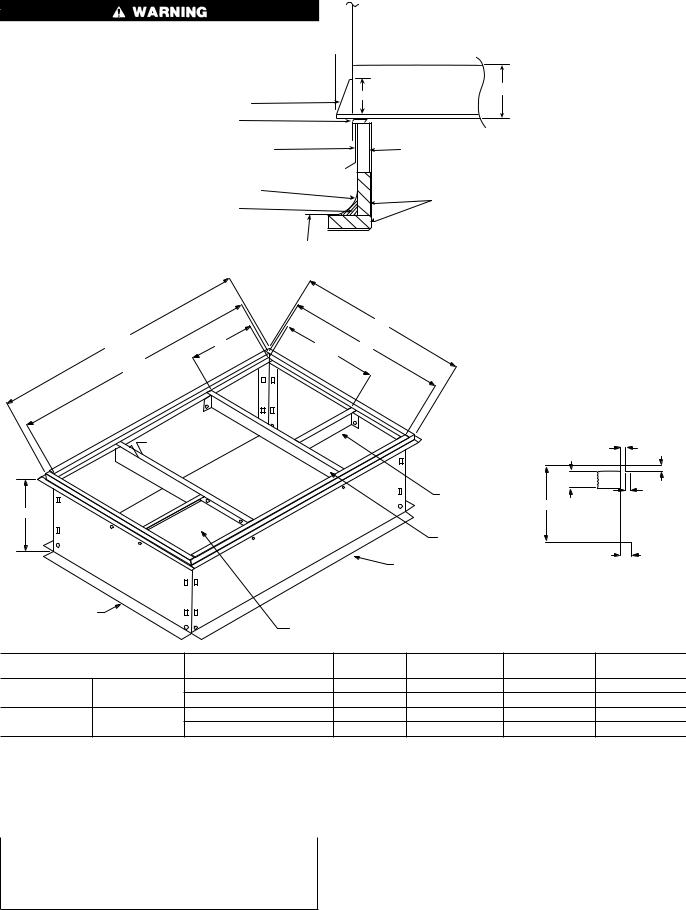
SIDE PANEL 
0.75" 

|
BASE PAN |
4.0" |
|
3.0" |
BOTTOM SUPPLY |
||
|
SUPPORT RIB(S)
SEAL STRIP |
|
(FACTORY SUPPLIED) |
|
COUNTER FLASHING |
NAILER |
(FIELD SUPPLIED) |
|
ROOFING FELT |
|
(FIELD SUPPLIED) |
|
CANT STRIP |
INSULATION |
(FIELD SUPPLIED) |
|
(FIELD SUPPLIED) |
|
ROOFING MATERIAL (FIELD SUPPLIED)
A99340
C
46 3/16 |
B |
17 3/8 |
D |
|
TYP.
44 5/16
|
1 TYP. |
|
|
|
|
7/8 |
|
|
|
|
|
|
|
||
|
|
|
|
|
3 |
|
|
|
|
|
|
SUPPORT B |
|
13/16 |
|
|
|
|
|
A |
|
||
B |
|
|
|
|
|
||
|
|
|
|
|
|
||
|
|
|
|
SUPPORT A (2) |
|
|
|
|
|
|
SIDE |
|
|
2 |
|
|
|
|
(2) |
|
|
END VIEW |
|
|
|
|
|
|
|
||
|
END |
|
|
|
|
|
|
|
(2) |
|
|
|
|
|
|
|
|
DECK PAN (INSULATED) |
|
|
|
||
|
|
|
|
|
|
A99320 |
|
UNIT SIZE |
ODS CATALOG NUMBER |
A |
B |
C |
D |
||
IN. [MM] |
IN. [MM] |
IN. [MM] |
IN. [MM] |
||||
|
|
|
|||||
50JS018-042 |
50JX024-036 |
CPRFCURB006A00 |
8 [203] |
11-27/32 [301] |
30-5/8 [778] |
28-3/4 [730] |
|
CPRFCURB007A00 |
14 [356] |
11-27/32 [301] |
30-5/8 [778] |
28-3/4 [730] |
|||
|
|
||||||
50JS048-060 |
50JX042-060 |
CPRFCURB008A00 |
8 [203] |
15/27/32 [402] |
42-18/ [1070] |
40-1/4 [1022] |
|
CPRFCURB009A00 |
14 [356] |
15-27/32 [402] |
42-1/8 [1070] |
40-1/4 [1022] |
|||
|
|
||||||
Fig. 4ÐRoof Curb Dimensions
NOTES:
1.Dimensions in [ ] are in millimeters.
2.Roof curb is made of 16 gage steel.
3.Table lists only the dimensions per part number that have changed.
4.Insulated panels: 1-in. thick fiberglass 1 lb density.
Before performing service or maintenance operations on system, turn off main power to unit. Turn off accessory heater power switch if applicable. Electrical shock could cause severe injury or death.
Step 1ÐGeneral
The 50JS and 50JX heat pumps are fully self-contained and designed for outdoor installation (See Fig. 1). Standard units are
shipped in a horizontal-discharge configuration for installation on a ground-level slab. Standard units can be converted to downflow (vertical) discharge configurations for rooftop applications.
RECEIVING AND INSTALLATION
Step 1ÐCheck Equipment
IDENTIFY UNIT Ð The unit model number and serial number are stamped on the unit identification plate. Check this information against shipping papers.
4
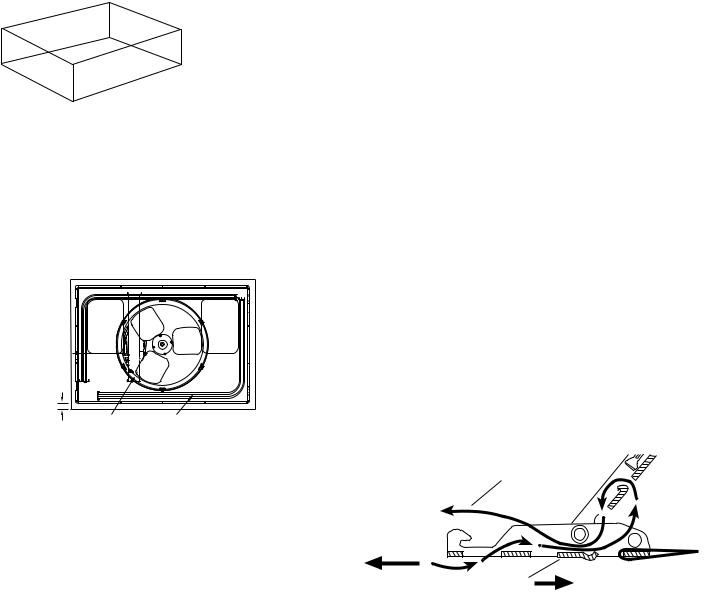
INSPECT SHIPMENT Ð Inspect for shipping damage while unit is still on shipping pallet. If unit appears to be damaged or is torn loose from its anchorage, have it examined by transportation inspectors before removal. Forward claim papers directly to transportation company. Manufacturer is not responsible for any damage incurred in transit. Check all items against shipping list. Immediately notify the nearest Carrier Air Conditioning office if any item is missing. To prevent loss or damage, leave all parts in original packages until installation.
Step 2ÐProvide Unit Support
ROOF CURB Ð Install accessory roof curb in accordance with instructions shipped with curb (See Fig. 4). Install insulation, cant strips, roofing, and flashing. Ductwork must be attached to curb.
IMPORTANT: The gasketing of the unit to the roof curb is critical for a watertight seal. Install gasketing material supplied with the roof curb. Improperly applied gasketing also can result in air leaks and poor unit performance.
Curb should be level to within 1/4 in. (See Fig. 5). This is necessary for unit drain to function properly. Refer to accessory roof curb installation instructions for additional information as required.
A |
C |
MAXIMUM ALLOWABLE
DIFFERENCE (in.)
B |
|
B-C |
A-C |
|
A-B |
||
|
|
|
|
1/4 |
1/4 |
1/4 |
|
|
|
|
|
C99065
Fig. 5ÐUnit Leveling Tolerances
SLAB MOUNT Ð Place the unit on a solid, level concrete pad that is a minimum of 4 in. thick with 2 in. above grade (See Fig. 6). The slab should extend approximately 2 in. beyond the casing on all 4 sides of the unit. Do not secure the unit to the slab except when required by local codes.
OPTIONAL |
OPTIONAL |
RETURN |
SUPPLY |
AIR |
AIR |
OPENING |
OPENING |
2"
EVAP. COIL |
COND. COIL |
C99096
Fig. 6ÐSlab Mounting Detail
GROUND MOUNT Ð The unit may be installed either on a slab or placed directly on the ground if local codes permit. Place the unit on level ground prepared with gravel for condensate discharge.
Step 3ÐProvide Clearances
The required minimum service clearances are shown in Figs. 2 and 3. Adequate ventilation and outdoor air must be provided. The outdoor fan draws air through the outdoor coil and discharges it through the top fan grill. Be sure that the fan discharge does not recirculate to the outdoor coil. Do not locate the unit in either a
corner or under an overhead obstruction. The minimum clearance under a partial overhang (such as a normal house overhang) is 36 in. above the unit top. The maximum horizontal extension of a partial over-hang must not exceed 36 in. For extended overhangs, provide a minimum clearance of 36 in.
IMPORTANT: Do not restrict outdoor airflow. An air restriction at either the outdoor-air inlet or the fan discharge may be detrimental to compressor life.
Do not place the unit where water, ice, or snow from an overhang or roof will damage or flood the unit. Do not install the unit on carpeting, tile, or other combustible materials. Slab-mounted units should be at least 4 in. above the highest expected water and runoff levels. Do not use unit if it has been under water.
Step 4ÐRig and Place Unit
Rigging and handling of this equipment can be hazardous for many reasons due to the installation location (roofs, elevated structures, etc.)
Only trained, qualified crane operators and ground support staff should handle and install this equipment.
When working with this equipment, observe precautions in the literature, on tags, stickers and labels attached to the equipment, and any other safety precautions that might apply.
Follow all applicable safety codes. Wear safety shoes and work gloves.
INSPECTION Ð Prior to initial use, and at monthly intervals, all rigging brackets and straps should be visually inspected for any damage, evidence of wear, structural deformation, or cracks. Particular attention should be paid to excessive wear at hoist hooking points and load support areas. Brackets or straps showing any kind of wear in these areas must not be used and should be discarded.
INSTALLATION
1.Remove unit from shipping carton. Leave top shipping skid on the unit as a spreader bar to prevent the rigging straps from damaging the unit. If the wood skid is not available, use a spreader bar of sufficient length to protect unit from damage.
2.Position the lifting bracket assembly around the base of the unit. Be sure the strap does not twist.
3.Place each of the 4 metal lifting brackets into the handholds in the composite pan.
4.Thread lifting bracket strapping around bottom perimeter of unit as follows:
a.Open lever of tension buckle (ratchet type).
b.Feed strapping through tension buckle as shown in Fig. 7.
c.Pull strapping through tension buckle unit taut.
d.Snap lever down to lock strap in tension buckle. To release strapping, squeeze safety latch, lift lever, and pull webbing outward.
HANDHOLD
HOOK
FEED
C99067
Fig. 7ÐThreading Belt
5
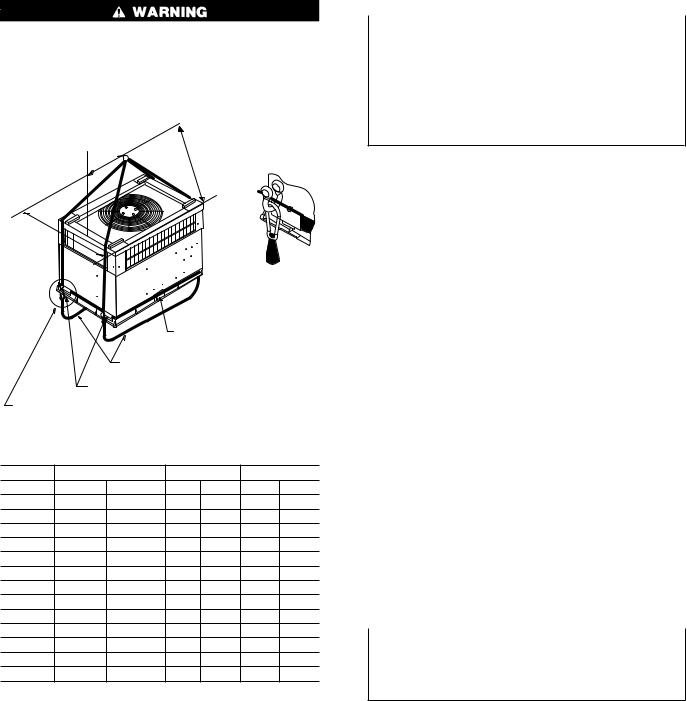
5.Tighten the tension buckle until it is taut. Lifting brackets must be secure in the handholds.
6.Attach field-supplied clevis or hook of sufficient strength to hole in the lifting bracket (See Fig. 8).
7.Attach the 2 safety straps directly to the clevis or hook at the 4 rigging brackets. DO NOT attach the safety straps to the lifting brackets (See Fig. 8).
|
|
|
|
914-137" |
|
|
|
|
“A” |
|
(36"-54") |
|
|
|
|
|
|
|
|
|
“B” |
|
|
|
|
|
|
|
|
|
|
|
DETAIL A |
|
|
|
|
|
|
SCALE 0.250 |
|
|
|
|
TIGHTEN STRAPPING SECURELY |
|
||
|
|
|
WITH TENSION BUCKLE |
|
|
|
|
|
INSTALL SAFETY STRAPS TO |
|
|
||
|
|
RIGGING CLEVIS AT 4 RIGGING BRACKETS |
|
|
||
|
|
PLACE RIGGING BRACKET ASSEMBLY IN 4 |
|
|
||
|
|
HAND HOLES AND INSTALL TIE DOWN STRAP |
|
|
||
|
|
AROUND PERIMETER OF UNIT AND THROUGH |
|
|
||
SEE DETAIL A |
|
SPACE IN BRACKET ASSEMBLY |
|
|
|
|
|
|
|
|
|
|
|
|
|
|
|
|
|
C99075 |
UNIT |
MAXIMUM WEIGHT |
|
A |
B |
|
|
Size |
lb. |
kg. |
in. |
mm. |
in. |
mm. |
50JS018 |
305 |
138.4 |
19.5 |
495.3 |
16.75 |
425.5 |
50JS024 |
311 |
141.1 |
18.5 |
469.9 |
16.75 |
425.5 |
50JS030 |
309 |
140.2 |
19.5 |
495.3 |
17.50 |
444.5 |
50JS036 |
313 |
142.0 |
19.5 |
495.3 |
17.75 |
450.9 |
50JS042 |
345 |
156.4 |
19.5 |
495.3 |
17.75 |
450.9 |
50JS048 |
375 |
170.1 |
20.5 |
520.7 |
20.62 |
523.8 |
50JS060 |
440 |
199.6 |
19.5 |
495.3 |
19.75 |
501.7 |
50JX024 |
321 |
145.6 |
19.0 |
482.6 |
18.25 |
463.6 |
50JX030 |
342 |
155.2 |
20.0 |
508 |
19.25 |
489 |
50JX036 |
350 |
158.8 |
20.0 |
508 |
19.0 |
482.6 |
50JX042 |
372 |
168.8 |
21.0 |
533.4 |
20.5 |
520.7 |
50JX048 |
377 |
171.0 |
20.0 |
508 |
21.25 |
539.8 |
50JX060 |
450 |
204.2 |
21.0 |
533.4 |
20.0 |
508.0 |
Fig. 8ÐSuggested Rigging
8.Position lifting point directly over the unit's center of gravity.
9.Lift unit. When unit is directly over the roof curb, remove the 2 safety straps. Lower the equipment onto the roof curb.
Step 5ÐSelect and Install Ductwork
The design and installation of the duct system must be in accordance with the standards of the NFPA for installation of non-residence type air conditioning and ventilating systems, NFPA 90A or residence-type, NFPA 90B and/or local codes and ordinances.
Select and size ductwork, supply-air registers, and return air grilles according to ASHRAE (American Society of Heating, Refrigeration, and Air Conditioning Engineers) recommendations.
The unit has duct flanges on the supplyand return-air openings on the side of the unit.
When designing and installing ductwork, consider the following:
For vertical supply and return units, tools or parts could drop into ductwork and cause serious injury or death. Install a 90 degree turn in the return ductwork between the unit and the conditioned space. If a 90 degree elbow cannot be installed, then a grille of sufficient strength and density should be installed to prevent objects from falling into the conditioned space. Units with electric heaters require 90 degree elbow in supply duct.
1.All units should have field-supplied filters or accessory filter rack installed in the return-air side of the unit. Recommended sizes for filters are shown in Tables 1A and 1B.
2.Avoid abrupt duct size increases and reductions. Abrupt change in duct size adversely affects air performance.
IMPORTANT: Use flexible connectors between ductwork and unit to prevent transmission of vibration. Use suitable gaskets to ensure weather tight and airtight seal. When electric heat is installed, use fireproof canvas (or similar heat resistant material) connector between ductwork and unit discharge connection. If flexible duct is used, insert a sheet metal sleeve inside duct. Heat resistant duct connector (or sheet metal sleeve) must extend 24-in. from electric heater element.
3.Size ductwork for cooling air quantity (cfm). The minimum air quantity for proper electric heater operation is listed in Tables 2A and 2B. Heater limit switches may trip at air quantities below those recommended.
4.Seal, insulate and weatherproof all external ductwork. Seal, insulate and cover with a vapor barrier all ductwork passing through conditioned spaces. Follow latest Sheet Metal and Air Conditioning Contractors National Association (SMACNA) and Air Conditioning Contractors Association (ACCA) minimum installation standards for residential heating and air conditioning systems.
5.Secure all ducts to building structure. Flash,weatherproof, and vibration-isolate duct openings in wall or roof according to good construction practices.
CONVERTING HORIZONTAL DISCHARGE UNITS TO DOWNFLOW (VERTICAL) DISCHARGE UNITS
Before performing service or maintenance operations on system, turn off main power to unit. Turn off accessory heater power switch if applicable. Electrical shock could cause serious injury or death.
1.Open all electrical disconnects before starting any service work.
2.Remove side duct covers to access bottom return and supply knock outs.
3.Use a screwdriver and hammer to remove the panels in the bottom of the base pan.
4.Reinstall the side duct covers to block off the horizontal air openings.
NOTE: These panels are held in place with tabs similar to an electrical knockout.
NOTE: Avoid abrupt duct size increases and reductions. Abrupt change in duct size adversely affects air performance.
Step 6ÐProvide for Condensate Disposal
NOTE: Ensure that condensate-water disposal methods comply with local codes, restrictions, and practices.
6
Table 1AÐPhysical Data
UNIT SIZE |
50JS018 |
|
50JS024 |
50JS030 |
|
50JS036 |
50JS042 |
|
50JS048 |
50JS060 |
NOMINAL CAPACITY (ton) |
1-1/2 |
|
2 |
2-1/2 |
|
2-1/2 |
3-1/2 |
|
4 |
5 |
|
|
|
|
|
|
|
|
|
|
|
OPERATING WEIGHT (lb) |
283 |
|
289 |
287 |
|
291 |
323 |
|
353 |
418 |
|
|
|
|
|
|
|
|
|
|
|
COMPRESSOR QUANTITY |
|
|
|
|
|
1 |
|
|
|
|
TYPE |
|
RECIPROCATING COMPRESSOR |
|
|
SCROLL COMPRESSOR |
|||||
|
|
|
|
|
|
|
|
|
|
|
REFRIGERANT |
|
|
|
|
|
R-22 |
|
|
|
|
|
|
|
|
|
|
|
|
|
|
|
REFRIGERANT METERING DEVICE |
|
|
|
|
|
Accurater ® |
|
|
|
|
Refrigerant (R-22) Quantity (lb.) |
5.6 |
|
5.2 |
5.8 |
|
7.1 |
7.6 |
|
7.8 |
8.6 |
|
|
|
|
|
|
|
|
|
|
|
ORIFICE ID (in.) |
0.053 |
|
0.061 |
0.068 |
|
0.078 |
0.078 |
|
0.088 |
0.093 |
|
|
|
|
|
|
|
|
|
|
|
ORIFICE OD (in.) |
0.040 |
|
0.049 |
2@0.042 |
|
2@0.046 |
2@0.052 |
|
2@0.057 |
2@0.061 |
OUTDOOR COIL |
1....17 |
|
1....17 |
1....17 |
|
2....17 |
2....17 |
|
2....17 |
2....17 |
Rows...Fins/in. |
|
|
|
|||||||
10.2 |
|
12.0 |
12.0 |
|
10.3 |
10.3 |
|
11.6 |
11.6 |
|
Face Area (sq ft) |
|
|
|
|||||||
|
|
|
|
|
|
|
|
|
|
|
|
|
|
|
|
|
|
|
|
|
|
OUTDOOR FAN |
2400 |
|
2400 |
2400 |
|
2800 |
2400 |
|
3300 |
3300 |
Nominal Airflow (CFM) |
|
|
|
|||||||
22 |
|
22 |
22 |
|
22 |
22 |
|
22 |
22 |
|
Diameter |
|
|
|
|||||||
1/8 (825) |
|
1/8 (825) |
1/8 (825) |
|
1/4 (1100) |
1/8 (825) |
|
1/4 (1100) |
1/4 (1100) |
|
Motor HP (RPM) |
|
|
|
|||||||
|
|
|
|
|
|
|
|
|
|
|
|
|
|
|
|
|
|
|
|
|
|
INDOOR COIL |
2....15 |
|
2....15 |
3....15 |
|
3....15 |
4....15 |
|
3....15 |
4....15 |
Rows...Fins/in. |
|
|
|
|||||||
3.7 |
|
3.7 |
3.7 |
|
3.7 |
3.7 |
|
4.7 |
4.7 |
|
Face Area (Sq Ft) |
|
|
|
|||||||
|
|
|
|
|
|
|
|
|
|
|
|
|
|
|
|
|
|
|
|
|
|
INDOOR BLOWER |
700 |
|
800 |
1000 |
|
1200 |
1250 |
|
1600 |
2000 |
Nominal Airflow (CFM) |
|
|
|
|||||||
10x10 |
|
10x10 |
11x10 |
|
11x10 |
11x10 |
|
11x10 |
11x10 |
|
Size (in.) |
|
|
|
|||||||
1/8 |
|
1/4 |
1/4 |
|
1/2 |
3/4 |
|
3/4 |
1 |
|
Motor (HP) |
|
|
|
|||||||
|
|
|
|
|
|
|
|
|
|
|
|
|
|
|
|
|
|
|
|
|
|
RETURN-AIR FILTERS (in.) |
20x20x1 |
|
20x20x1 |
20x20x1 |
|
20x24x1 |
24x30x1 |
|
24x30x1 |
24x30x1 |
Throwaway |
|
|
|
|||||||
|
|
|
|
|
|
|
|
|
|
|
|
|
|
|
|
|
|
|
|
|
|
Table 1BÐPhysical Data
UNIT SIZE |
50JX024 |
50JX030 |
50JX036 |
|
50JX042 |
50JX048 |
50JX060 |
|
|
|
|
|
|
|
|
NOMINAL CAPACITY (ton) |
2 |
2 1/2 |
3 |
|
3-1/2 |
4 |
5 |
OPERATING WEIGHT (lb) |
299 |
320 |
328 |
|
350 |
355 |
420 |
|
|
|
|
|
|
|
|
COMPRESSOR QUANTITY |
|
|
|
1 |
|
|
|
|
|
|
|
|
|
|
|
TYPE |
|
|
SCROLL COMPRESSOR |
|
|
||
REFRIGERANT |
|
|
|
R-22 |
|
|
|
|
|
|
|
|
|
|
|
REFRIGERANT METERING DEVICE |
|
|
Accurater ® |
|
|
||
|
|
|
|
|
|
|
|
Refrigerant (R-22) Quantity (lb.) |
5.5 |
6.4 |
7.0 |
|
10.8 |
10.4 |
12.3 |
|
|
|
|
|
|
|
|
ORIFICE ID (in.) |
0.065 |
0.073 |
0.076 |
|
0.080 |
0.088 |
0.0.93 |
ORIFICE OD (in.) |
0.055 |
0.065 |
0.067 |
|
2@0.052 |
2@0.057 |
2@0.063 |
|
|
|
|
|
|
|
|
OUTDOOR COIL |
1...17 |
2...17 |
2...17 |
|
2...17 |
2...17 |
2...17 |
Rows...Fins/in. |
|
||||||
14.6 |
10.9 |
10.9 |
|
14.4 |
14.4 |
16.4 |
|
Face Area (sq ft) |
|
||||||
|
|
|
|
|
|
|
|
OUTDOOR FAN |
2350 |
2350 |
2800 |
|
2800 |
3300 |
3300 |
Nominal Airflow (CFM) |
|
||||||
22 |
22 |
22 |
|
22 |
22 |
22 |
|
Diameter |
|
||||||
1/8 (825) |
1/8 (825) |
1/4 (1100) |
|
1/8 (825) |
1/4 (1100) |
1/4 (1100) |
|
Motor HP (RPM) |
|
||||||
|
|
|
|
|
|
|
|
|
|
|
|
|
|
|
|
INDOOR COIL |
3...15 |
3...15 |
4...15 |
|
4..15 |
4...15 |
4...15 |
Rows...Fins/in. |
|
||||||
3.7 |
3.7 |
3.7 |
|
4.7 |
4.7 |
5.7 |
|
Face Area (Sq Ft) |
|
||||||
|
|
|
|
|
|
|
|
INDOOR BLOWER |
800 |
1000 |
1200 |
|
1400 |
1600 |
2000 |
Nominal Airflow (CFM) |
|
||||||
10x10 |
11x10 |
11x10 |
|
11x10 |
11x10 |
11x10 |
|
Size (in.) |
|
||||||
1/4 |
1/4 |
1/2 |
|
3/4 |
3/4 |
1 |
|
Motor (HP) |
|
||||||
|
|
|
|
|
|
|
|
RETURN-AIR FILTERS (in.) |
20x20x1 |
20x20x1 |
20x24x1 |
|
24x30x1 |
24x30x1 |
24x30x1 |
Throwaway |
|
||||||
|
|
|
|
|
|
|
|
|
|
|
|
|
|
|
|
NOTE: Air filter pressure drop for non-standard filters must not exceed 0.08 in. wg.
Table 2AÐMinimum Airflow for Reliable Electric Heater Operation (Cfm)
SIZE |
50JS018 |
50JS024 |
50JS030 |
50JS036 |
50JS042 |
50JS048 |
50JS060 |
AIRFLOW (CFM) |
650 |
800 |
1000* |
1200 |
1400 |
1600 |
2000 |
|
|
|
|
|
|
|
|
Table 2BÐMinimum Airflow for Reliable Electric Heater Operation (Cfm)
SIZE |
50JX024 |
50JX030 |
50JX036 |
50JX042 |
50JX048 |
50JX060 |
|
|
|
|
|
|
|
AIRFLOW (CFM) |
800 |
1000* |
1200 |
1400 |
1600 |
2000 |
|
|
|
|
|
|
|
* The 030 size models must be run on medium or high speed when used in conjunction with 15 Kw electric heat accessory.
7
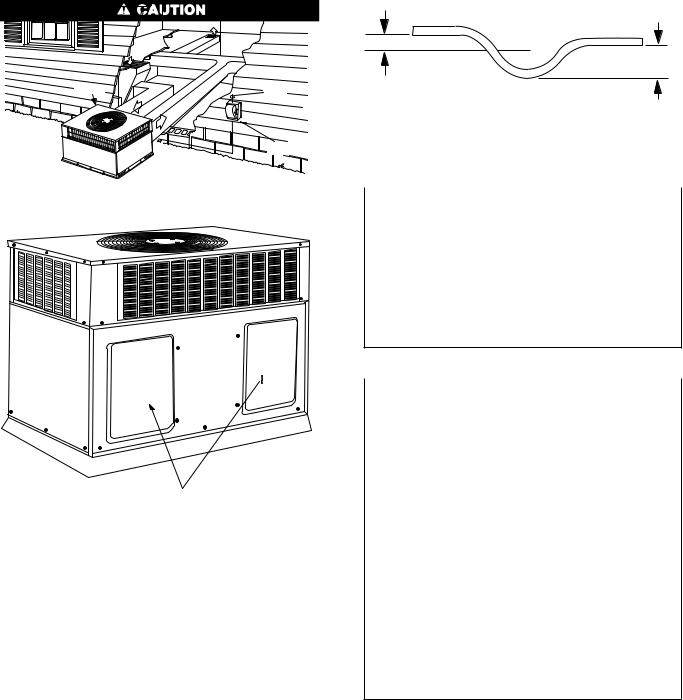
INDOOR

 THERMOSTAT
THERMOSTAT
RETURN
AIR
FROM
TOP COVER POWER
SOURCE
DISCONNECT
PER NEC
C99061
Fig. 9ÐTypical Installation
Accessory Duct Covers
C99030
Fig. 10Ð50JX with Duct Covers On (Unit shown with optional louvered grille)
The units dispose of condensate through a 3/4 in. NPT female fitting that exits on the compressor end of the unit. Condensate water can be drained directly onto the roof in rooftop installations (where permitted) or onto a gravel apron in ground level installations. Install a field-supplied condensate trap at end of condensate connection to ensure proper drainage. Make sure that the outlet of the trap is at least 1 in. lower than the drain-pan condensate connection to prevent the pan from overflowing. Prime the trap with water. When using a gravel apron, make sure it slopes away from the unit.
If the installation requires draining the condensate water away from the unit, install a field-supplied 2 -in. trap at the condensate connection to ensure proper drainage. Condensate trap is available as an accessory or is field-supplied. Make sure that the outlet of the trap is at least 1 in. lower than the unit drain-pan condensate connection to prevent the pan from overflowing. Connect a drain trough using a minimum of field-supplied 3/4 -in. PVC or field-supplied 3/4 -in. copper pipe at outlet end of the 2 -in. trap (See Fig. 11). Do not undersize the tube. Pitch the drain trough downward at a slope of at least 1 in. every 10 ft of horizontal run. Be sure to check the drain trough for leaks. Prime the trap at the beginning of the cooling season start-up.
1” MIN.
TRAP
OUTLET
2” MIN.
C99013
Fig. 11ÐCondensate Trap
Step 7ÐInstall Electrical Connections
The unit cabinet must have an uninterrupted, unbroken electrical ground to minimize the possibility of personal injury if an electrical fault should occur. This ground may consist of an electrical wire connected to the unit ground lug in the control compartment, or conduit approved for electrical ground when installed in accordance with NEC, ANSI/NFPA American National Standards Institute/National Fire Protection Association (latest edition) (in Canada, Canadian Electrical Code CSA C22.1) and local electrical codes. Failure to adhere to this warning could result in serious injury or death.
Failure to follow these precautions could result in damage to the unit being installed:
1.Make all electrical connections in accordance with NEC ANSI/NFPA (latest edition) and local electrical codes governing such wiring. In Canada, all electrical connections must be in accordance with CSA standard C22.1 Canadian Electrical Code Part 1 and applicable local codes. Refer to unit wiring diagram.
2.Use only copper conductor for connections between field-supplied electrical disconnect switch and unit. DO NOT USE ALUMINUM WIRE.
3.Be sure that high-voltage power to unit is within operating voltage range indicated on unit rating plate. On 3-phase units, ensure phases are balanced within 2%. Consult local power company for correction of improper voltage and/or phase imbalance.
4.Insulate low-voltage wires for highest voltage contained within conduit when low-voltage control wires are in same conduit as high-voltage wires.
5.Do not damage internal components when drilling through any panel to mount electrical hardware, conduit, etc.
HIGH-VOLTAGE CONNECTIONS Ð The unit must have a separate electrical service with a field-supplied, waterproof disconnect switch mounted at, or within sight from the unit. Refer to the unit rating plate, NEC and local codes for maximum fuse/circuit breaker size and minimum circuit amps (ampacity) for wire sizing (See Tables 3A and 3B for electrical data).
The field-supplied disconnect may be mounted on the unit over the high-voltage inlet hole (See Figs. 2-3).
If the unit has an electric heater, a second disconnect may be required. Consult the Installation, Start-Up and Service Instructions provided with the accessory for electrical service connections.
Operation of unit on improper line voltage constitutes abuse and may cause unit damage that could affect warranty.
ROUTING POWER LEADS INTO UNIT Ð Use only copper wire between disconnect and unit. The high-voltage leads should
8
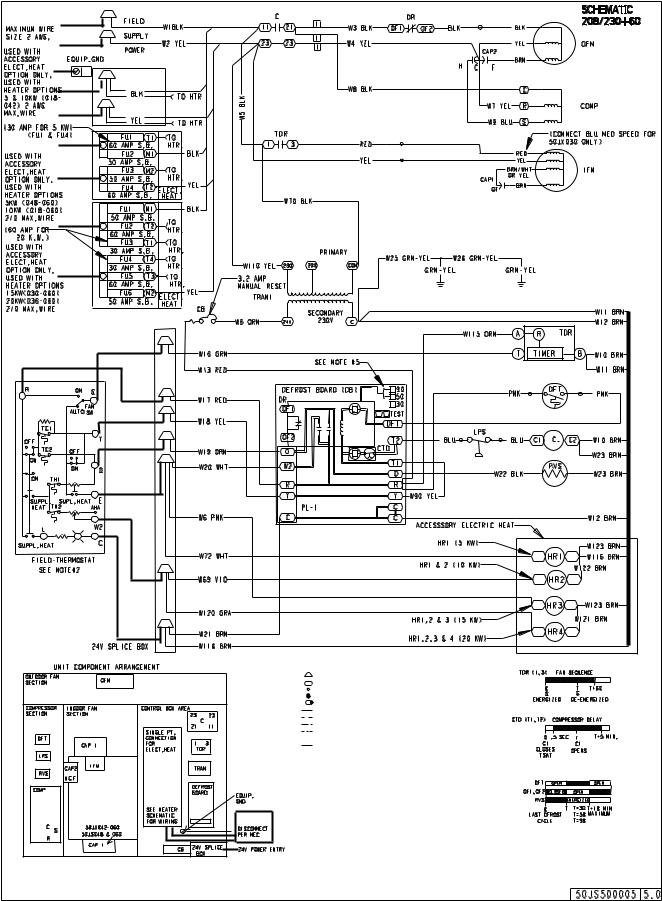
LEGEND
FIELD SPLICE TERMINAL (MARKED) TERMINAL (UNMARKED) SPLICE
SPLICE (MARKED)
FACTORY WIRING FIELD CONTROL WIRING FIELD POWER WIRING
ACCESSORY OR OPTIONAL WIRING
TO INDICATE COMMON POTENTIAL ONLY:
NOT TO REPRESENT WIRING
AHA |
ADJUSTABLE HEAT ANTICIPATOR |
C |
CONTACTOR |
CAP |
CAPACITOR |
CB |
CIRCUIT BREAKER |
COMP |
COMPRESSOR MOTOR |
CTD |
COMPRESSOR TIME DELAY |
DB |
DEFROST BOARD |
DFT |
DEFROST THERMOSTAT |
DR |
DEFROST RELAY |
EQUIP |
EQUIPMENT |
FU |
FUSE |
GND |
GROUND |
HR |
HEATER RELAY |
HTR |
HEATER |
IFM |
INDOOR FAN MOTOR |
LPS |
LOW PRESSURE SWITCH |
OFM |
OUTDOOR FAN MOTOR |
QT |
QUADRUPLE TERMINAL |
RVS |
REVERSING VALVE SOLENOID |
S.B. |
SLOW BLOW FUSE |
TC |
THERMOSTAT - COOLING |
TDR |
TIME DELAY RELAY |
TH |
THERMOSTAT - HEATING |
TRAN |
TRANSFORMER |
NOTES:
1. IF ANY OF THE ORIGINAL WIRES FURNISHED ARE REPLACED, IT MUST BE REPLACED WITH TYPE 90 DEGREE C WIRE OR IT’S EQUIVALENT.
2. SEE PRICE PAGES FOR THERMOSTAT AND SUBBASES.
3. USE 75 DEGREE COPPER CONDUCTORS FOR FIELD INSTALLATION.
4.FOR HIGH SPEED IFM, DISCONNECT RED
WIRE FROM TDR 3 AND CONNECT BLK WIRE FROM IFM. FOR MEDIUM SPEED, DISCONNECT RED WIRE
FROM TDR 3 AND CONNECT BLU WIRE FROM IFM.
5.DEFROST TIMER TO BE SET AT 90 MINUTES EXCEPT FOR 50JS048, 060 MODELS
SET AT 50 MINUTES.
A00073
Fig. 12ÐWiring Schematics
9
